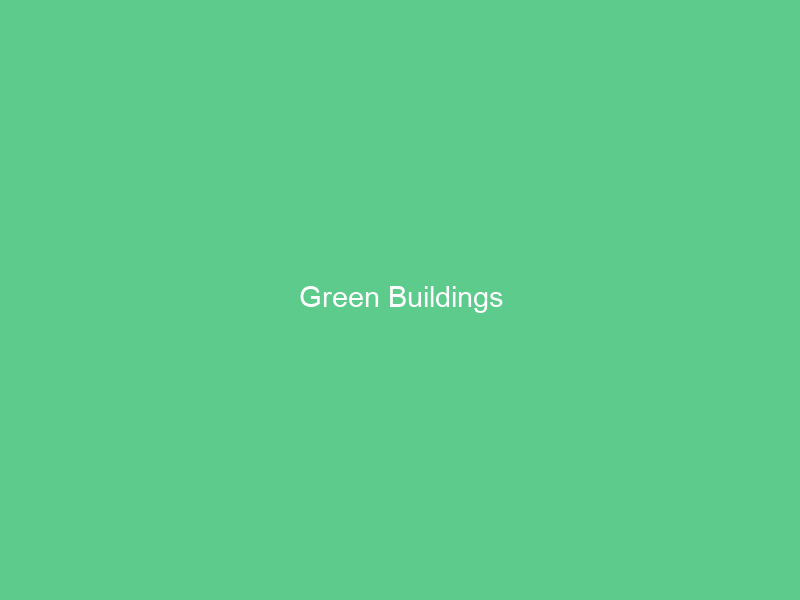Green buildings help the environment by lowering their carbon footprint and cutting back on energy and resource use.
Reduce waste through recycling materials and efficient construction practices; they use engineered wood products, low VOC paints and other sustainable materials that promote sustainability.
Comfort is achieved with natural lighting, low drafts and insulated windows. Utilizing solar panels or other renewable energy sources reduces fossil fuel dependence.
Energy Efficiency
Implementing energy efficiency and renewable energy generation techniques during construction helps to minimize environmental impact while decreasing reliance on non-renewable sources of power. Solar panels, wind turbines and other renewable technologies such as bifilacial solar panels that capture light on both sides or building integrated photovoltaic (BIPV) panels are commonplace features in green buildings.
Green buildings generally avoid construction materials known to release volatile organic compounds (VOCs) during manufacturing, thus lowering risk and being more eco-friendly.
Green buildings are typically designed to incorporate natural lighting, ventilation and plants to improve indoor air quality and make them healthier for occupants, which may reduce absenteeism due to respiratory ailments and boost productivity. Furthermore, these green buildings may even house home batteries which store solar-generated energy so it can be used off-grid when not shining brightly reducing dependency on grid energy.
Water Efficiency
As urbanisation continues to accelerate, green buildings have become an essential element in creating more responsible city development. Green buildings help reduce energy and water consumption as well as carbon emissions while supporting biodiversity.
Water efficiency in green buildings is achieved by making use of alternative water sources like rainwater and grey water systems, low-flow aerators and other technologies to save water are installed, as are waterless urinals and composting toilets as strategies to save on costs.
These measures reduce stress on shared water resources while simultaneously lowering operating costs, improving indoor air quality, contributing to human health by decreasing exposure to potentially toxic substances, and helping create green construction projects – helping avoid respiratory allergies or illnesses caused by their presence.
Indoor Air Quality
Green buildings prioritize occupant comfort, health and productivity by creating healthy indoor environments through strategies such as air filtration, lighting and ventilation. Studies have revealed that those occupying green homes tend to experience less sickness and greater productivity levels.
Poor indoor air quality has serious negative health repercussions for individuals, such as respiratory ailments, allergies and fatigue. Environmental factors may also impact cognitive functioning – according to one recent study comparing cognitive function between green homes with increased ventilation and conventional homes with no ventilation at all, participants performed 30% better on cognitive tests in green homes with increased ventilation.
Green buildings aim to achieve optimal indoor air quality (IAQ) through various strategies, including bringing outdoor air in through ventilation systems and using non-toxic and low emitting materials such as non-toxic carpeting. Furthermore, permeable pavement, green landscaping techniques and moisture management techniques all play their parts to prevent dampness from entering and further improve IAQ.
Materials
Attaining resource efficiency, green buildings often incorporate state-of-the-art ventilation systems, optimized daylighting strategies and sustainable materials that are biodegradable and free of toxic substances into their designs. Furthermore, waste reduction efforts such as salvaging, remanufacturing and recycling materials is often prioritized within this framework.
Eco-friendly construction materials such as bamboo, recycled steel and repurposed wood along with renewable energy generators and water heating panels are used extensively in green structures. Green roofs, rain gardens and permeable surfaces help minimize rainwater runoff while simultaneously reducing flooding, erosion and groundwater replenishment.
Teams seeking green certification must be capable of analyzing economic trade-offs and understanding their effects, such as long-term sourcing agreements or sustainability targets such as net zero for infrastructure or buildings. Furthermore, they should track emissions performance data as an aid for competitive selection purposes.
Life Cycle
Numerous green buildings utilize recycled materials like reclaimed wood, recycled insulation and solar panels to reduce waste and conserve natural resources. Furthermore, water-efficient equipment and low-flow toilets help cut energy consumption while encouraging rainwater use and non-potable sources.
Green building practices not only reduce carbon emissions but can also protect the environment by eliminating construction-related pollutants like dust pollution – which has been linked to lung diseases and other health concerns – by decreasing strain on local water systems and providing access to clean drinking water.
However, green buildings do have their limitations. Renewable energy sources may fluctuate with weather conditions and lead to irregular power supplies; this may reduce their full benefits and thus limit green buildings’ full benefits.

